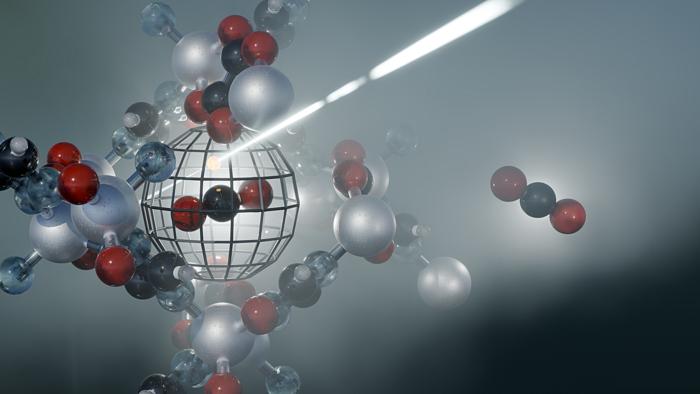As global industries grapple with the urgent need to reduce carbon emissions, innovative solutions in carbon capture technology have taken center stage. At the forefront of these advances is a remarkable material known as CALF-20, a zinc-based metal-organic framework (MOF) that promises exceptional efficiency in capturing carbon dioxide (CO₂) even under challenging humid conditions. A recent collaborative investigation by researchers from the Helmholtz-Zentrum Dresden-Rossendorf (HZDR), Dresden University of Technology (TUD), and Maria Curie-Skłodowska University in Lublin, published in the journal Small, reveals intricate details of CALF-20’s gas adsorption dynamics. Leveraging cutting-edge techniques including positron annihilation lifetime spectroscopy (PALS), the study elucidates the structural adaptability and selective adsorption behaviors of this MOF, underscoring its potential as a game-changer in industrial carbon capture.
Carbon capture materials must meet stringent requirements: selectively adsorbing CO₂ from complex gas mixtures while minimizing energy consumption in regeneration cycles. Traditional adsorbents like activated carbon and zeolites have had limited success, especially under humid conditions where water competes with CO₂ for adsorption sites. CALF-20 distinguishes itself with its ability to preferentially capture CO₂ while demonstrating high resistance to moisture interference. This MOF features a porous, sponge-like architecture formed by metal-oxygen clusters interconnected with organic linkers, creating a robust network of nanocavities optimized for gas sorption. Its balanced heat of adsorption allows for efficient CO₂ uptake without demanding excessive energy input during desorption.
The research team employed a multifaceted methodological approach to probe the physicochemical interactions within CALF-20. Notably, positron annihilation lifetime spectroscopy (PALS) was pivotal in analyzing the internal voids and molecular occupation within the material under varying temperatures and humidity. PALS, sensitive to the presence and size of free volume in porous solids, tracks the lifetime of positronium atoms—exotic bound states of electrons and positrons—that are quenched differently depending on the local microenvironment. This allowed researchers to monitor how CO₂ molecules infiltrate the nanopores and alter their structure in real time, offering a dynamic view not achievable with conventional gas adsorption measurements alone.
One of the standout findings was the stepwise adsorption mechanism of CO₂ inside CALF-20. Initial adsorption occurs at the center of nanopores, where CO₂ molecules form ordered clusters before progressively binding to the pore walls at higher pressures. This nuanced understanding of molecular arrangement and progression within the framework provides critical insight into optimizing material design for enhanced performance. Moreover, PALS detected residual free volumes even after saturation, implying that CALF-20’s porous network maintains accessible vacant sites that could facilitate higher throughput or accommodate additional molecular species.
Beyond CO₂, the interplay between water vapor and the MOF was extensively examined, given that industrial gas streams rarely exist in dry conditions. Under low humidity levels, water molecules manifest as isolated clusters within CALF-20’s structure, minimally hindering CO₂ capture. As relative humidity rises above 40%, these water molecules coalesce into continuous hydrogen-bonded networks that increasingly dominate adsorption sites. Despite this, CALF-20 exhibits remarkable resilience, preserving notable CO₂ uptake efficiency in moderately humid environments where many conventional adsorbents falter. This balance between water tolerance and selective carbon capture positions CALF-20 as a practical solution for real-world industrial emissions.
Crucially, CALF-20 has progressed beyond mere synthesis and characterization to multi-kilogram scale production, a milestone indicating readiness for pilot-scale testing and implementation. Developed initially at the University of Calgary, its synthesis protocols have been optimized for scalability without compromising structural integrity or adsorption performance. This transition from academic novelty to tangible carbon capture agent fuels hope for integration into existing industrial processes, where moisture tolerance and regeneration efficiency are paramount.
Moreover, the relatively gentle heat of adsorption observed in CALF-20 points toward energy savings during regeneration cycles, mitigating one of the significant operational costs in carbon capture and storage (CCS) technologies. Since adsorbent regeneration often consumes a substantial portion of the overall energy budget, materials that combine effective capture with low-energy release profiles address a fundamental bottleneck in CCS economics.
This study underscores the pivotal role of advanced material science coupled with innovative analytical techniques in tackling climate change challenges. By unraveling the dynamic processes governing CO₂ capture in a complex, moisture-rich environment, the findings illuminate routes to optimize both material performance and process integration. CALF-20, through its unique blend of selectivity, moisture resilience, and scalable synthesis, stands poised as a promising candidate to enhance global carbon mitigation strategies and facilitate the transition toward a low-carbon future.
Subject of Research: Not applicable
Article Title: Uncovering the dynamic CO2 gas uptake behavior of CALF-20 (Zn) under varying conditions via positronium lifetime analysis
News Publication Date: 25-Feb-2025
Web References: DOI link
References:
A. G. Attallah, V. Bon, E. Hirschmann, M. Butterling, A. Wagner, R. Zaleski, S. Kaskel, “Uncovering the dynamic CO₂ gas uptake behavior of CALF-20 (Zn) under varying conditions via positronium lifetime analysis,” Small, 2025.
Image Credits: B. Schröder/HZDR
Keywords
Green chemistry, Inorganic chemistry
Tags: advanced carbon capture techniquesCALF-20 metal-organic frameworkcarbon capture technologyCO₂ adsorption efficiencyenvironmental sustainability technologiesgas adsorption dynamicsHelmholtz-Zentrum Dresden-Rossendorf researchindustrial carbon capture solutionsinnovative carbon capture materialsmoisture-resistant carbon captureporous materials for carbon captureselective CO₂ capture





